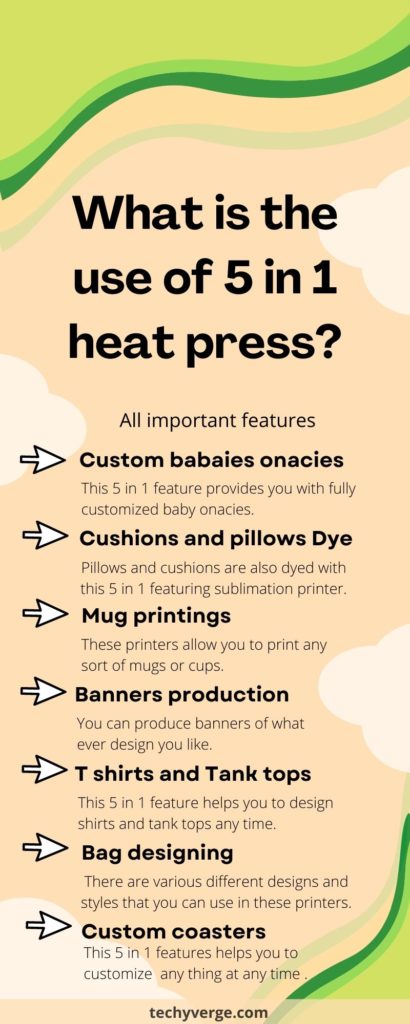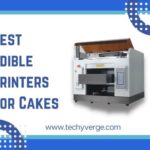There are a few different things that a 5 in 1 heat press can do, making it a versatile piece of equipment. 10 Easy things that 5 in heat press can make includes:
- Custom Baby Onesies
- DIY Throw Pillows & Cushions
- Make A Reverse Canvas
- Personalised T-Shirts & Tank Tops
- Custom Coasters
- A Slice Tool Project
- A Layered HTV Project
- Tote Bags
- Banners
- Personalised Mugs
What is Use of 5 in 1 Heat Press for?
Some of the most common uses for a 5-in-1 heat press include transferring images and designs onto t-shirts, cups, and other items; creating custom mugs and plates; and even pressing flowers to create unique keepsakes.

With so many different uses, a 5-in-1 heat press is an essential tool for anyone who enjoys crafting or working with their hands.
Do you know: Whether computer is required for sublimation?
What Can I Make with a 5 in 1 Heat Press?
Even though five-in-one heat presses or multipurpose heat presses have existed for a long time, they have only recently begun to gain popularity. A lot of these machines were even unavailable on platforms like Amazon up until late 2019 if you were looking for them.
There are now several varieties of these helpful, space-saving, multifunction machines to choose from and the prices differ too, which regrettably adds to the confusion of what they are capable of.
The following is an explanation of what a typical 5-in-1 heat press can do:
T-Shirts, Bibs, Flags, & Mouse Pads can all be made with a 5 in 1 Heat Press. The selection of products includes 11 to 15 oz Coffee Mugs, Large and Small Latte Mugs, Espresso Mugs, Hats, Hairpieces, and Small and Large Plates.
There are so many things you can make with all 5 attachments that crafters are able to make so much more than what was mentioned above.
Choosing a Sublimation Heat Press
The formation of molecular bonds is an essential part of the chemical process known as sublimation. In order to get the desired results, precise heat-press parameters in terms of time, temperature, and pressure are required.
Even a little change in any one of these characteristics may have an impact on the picture quality.
In light of this, it is imperative that you invest in a high-quality sublimation heat press that is able to provide and maintain the proper settings for each and every project. The uplifting news is that they come in a variety of dimensions, combinations, and levels of quality to choose from.
In terms of dependability and output, a heat press may give the impression of being a very simple piece of equipment; nonetheless, there are important aspects of the machine that are hidden from view.
Time
Timers that can be programmed are standard equipment for all heat presses. The majority of them start working when the press is closed, and a buzzer goes off after the predetermined amount of time has passed so that the operator knows when to open it.
After a certain amount of time has passed, some heat presses release their products automatically. Because of this, the transfer paper could move ever-so-slightly on the substrate, which might lead to “ghosting” of the image and ultimately destroy the object that is being sublimated.
If you use a heat press like this one, you may want to think about turning off the auto-open option. In the event that you want to keep it enabled, check to see that the transfer is correctly attached to the substrate.
Temperature
In order to successfully sublimate most items, a temperature of 400 degrees Fahrenheit must be maintained for one minute. Even a very little shift of a few degrees may have a significant impact on the colours and features of the finished picture.
Upper and lower platens are the components that make up heat presses. The first kind includes heating components, while the second type provides support for the substrate while it is being pressed.
(It’s important to note that certain presses have hot platens on both the upper and lower positions.) Presses à chaleur de qualité are equipped with dependable heating components that maintain an appropriate temperature with very minute variations (drifting).
Additionally, the heating components guarantee that the temperature of the top platen is continuous throughout the whole surface. This eliminates the possibility of “cold patches,” which may result in an image that has uneven coloration when sublimated.
In order to keep the price of the heat press down, some manufacturers create it with pieces of inferior quality that are farther apart. It is possible for these devices to have a substantially cheaper price tag in addition to a higher output quality.
This may be useful for certain additional uses, such as heat transfers; however, it is not ideal for sublimation.
Pressure
The top platen is responsible for applying pressure to the substrate in addition to providing heat to it. In order to ensure that the platen does not “give” at any point throughout the pressing process, it is essential that it be level, even, and manufactured of high-quality materials.
The quality of the sublimation will suffer if the pressure is applied inconsistently or unevenly, which will result in an imbalance of colour, inaccurate details, and maybe ghosting.
In order to keep the price down, heat presses of lower grade are often constructed out of materials that are not as significant. Since pressure is not a significant component in the majority of other applications, an uneven platen will have little to no impact, if any effect at all. However, it is an essential component in producing sublimation of a good grade.
5 in 1 Heat Press Review
Characteristics of Being Heat-Pressed
When looking for a heat press to use for sublimation, pay attention to the size, shape, and thickness of the finished product you wish to create. The size of the heat press is clearly an important consideration given that it has to be big enough to fully cover the area that is being painted.
Curved things, such as cups, need a different pressing approach than flat items, while thick substrates require different solutions than thin ones. Flat products, on the other hand, may be pressed using the same technique as flat items.
When doing a comparison of heat presses, keep the following physical considerations in mind:
1. Structure Comprised of Platens
The majority of sublimation substrates are compressed using a flat heat press. These presses come in a variety of sizes and may have one of three distinct platen configurations: a clam-shell, swing-away, or drawer platen.
The most popular form of heat press is known as the clam-shell unit. The top and bottom platens of the press are joined by a hinge, and the press opens and closes in an angular manner, which is where the name comes from.
Although these units are adequate for use with thin substrates, there is a possibility that unequal pressure will be applied to bulkier objects such as plaques, ceramic tiles, flip-flops, and other similar things.
This is due to the fact that a greater amount of pressure will be exerted closer to the hinge, while a lesser amount will be applied farther away.
The end result might be images with an inconsistent tone and colours that are out of proportion. Some of the clam-shell types include a complex hinge mechanism, which makes them more suited for storing objects with a greater thickness.
The top platens of swing-away units are attached on an arm that allows them to be moved vertically up and down. This motion applies the same pressure throughout the whole of the substrate’s surface, irrespective of the substrate’s thickness.
When the heat press is opened, the top plate may swing to one side, making it simpler to reach the bottom plate for putting and aligning substrates. In addition, the lower platen can be moved in either of two directions.
Drawer heat presses also have an upper plate that is fixed to the machine and may be raised and lowered, but it does not swing. Instead, the bottom platen may be pulled forward, which makes access much simpler. This sort of device is effective for both thin and thick substrates and works well with both.
2. Platen Size
The size of the platen is the most significant consideration to make when selecting a heat press since it establishes the maximum image dimensions that may be used. It is essential for excellent sublimation that the heat be distributed uniformly throughout the whole surface.
Due to the fact that the temperature might drop near the outside margins of the heat press, you should only deal with pictures that are less than the size of the platen.
If you have a good heat press, you should assume that there is a buffer zone of one inch on all four corners. (This may be an unnecessarily cautious approach, since the process of sublimation is sensitive to heat.) Therefore, the usable heating surface of a press with dimensions of 20 inches by 24 inches would be 18 inches by 22 inches.
A good rule of thumb is to make sure that the maximum field size of the heat press is at least one inch greater on all four sides than the maximum field size of the printer. For instance, if the printer is capable of producing prints of 13 inches by 19 inches, the size of the heat press should be at least 14 inches by 20 inches.
3. Manual or Pneumatic
On the majority of substrates, it is advised that a pressure of 40 psi be applied during the sublimation process. On the other hand, the majority of presses do not have pressure indicators, thus in most cases, medium pressure is sufficient.
The vast majority of heat presses have a mechanical closing mechanism that must be controlled by hand. The pressure on the platen may be altered by turning a knob, which in turn engages a jack-screw mechanism that adjusts the position of the top platen in proportion to the position of the lower platen.
This influences how much pressure is applied to the surface of the substrate when the press is closed because it controls the space between the two surfaces when the press is closed. Depending on the item’s thickness or thinness, the gap should either be extended or lowered to accommodate it.
There are a variety of heat presses that may be purchased as systems that are controlled by pneumatics. They shut the platen with the help of air pressure, and then they apply a certain amount of pressure to the surface of the substrate. When the pushing procedure has been completed, the system will open on its own.
Systems that are pneumatic have two major benefits over those that are manual. To begin, the operator of the system is not required to utilise any kind of physical effort in order to run it, which lowers the risk of injuries caused by repeated motion.
Second, it is possible to specify exact pressure settings, which makes it fast and simple to set up various kinds of substrates for manufacturing. This is a significant advantage. Because of this, it will also be feasible to reproduce the pressure settings on subsequent operations.
Manual pressure settings, on the other hand, are not focused on accuracy but rather on feel. When it comes to configuring work, this results in a lot of trial and error, and it also makes it impossible to repeat precise settings on subsequent orders.
The heat press is an essential component of the sublimation manufacturing process; hence, you should prioritise the acquisition of a dependable device that is capable of maintaining a consistent temperature during each task.
Choose a device from a reputable vendor that also provides technical support, replacement parts, and servicing. Instead of concentrating on the buying price in the near term, you should concentrate on the investment.
Pressing Products Tailored to Specific Needs
Curved and rounded goods need the use of specialised heat presses, such as a mug or cap press, which have curved surfaces specifically intended to suit the contours of the respective products. The use of specific attachments allows combination presses to do both flat and curved pressing in addition to their other capabilities.
Heat presses developed specifically for three dimensions may also be used on objects with curved surfaces. In addition to this, they are able to apply pictures to many surfaces of a single substrate, such as the top and sides of the cover of a mobile phone.
This kind of press does not have a platen; instead, it makes use of a vacuum system to wrap a membrane as tightly as possible around the substrate before applying convection heat.
Wraps are an alternative to presses for certain rounded items and may be utilised with such products. Transfers are attached to the substrate using a specialised wrap designed to withstand high temperatures.
This wrap completely encircles the object, and it then snaps into position. After that, the substrate is put into an oven that uses convection for a significant amount of time, often between 12 and 15 minutes.
Wraps come in a variety of sizes and may be used for a wide variety of items, including mugs, bowls for pet food, cookie jars, and so on.
Last but not least, a rotary press, also known as a calendar press, is a piece of equipment with a continuous feed that is used for pressing fabric as it emerges from a roll-style sublimation printer. The cloth is “pressed” by a succession of hot rollers as it moves through the sublimation process. In most cases, it is used for pressing big quantities of cloth.
- Can You Sublimate on Nylon and Polyester? Which oneis the Best - February 19, 2024
- Converted Epson Eco Tank Et-2800 Vs Et-2803 Sublimation Printer [Review 2024] - February 19, 2024
- Can You Reuse Sublimation Prints? (The Righ Answer) - February 19, 2024






![Top 100+ FAQs Related to Sublimation Printing & Heat Press [Updated 2024] faqs related to sublimation Printing](https://www.techyverge.com/wp-content/uploads/2022/08/faqs-related-to-sublimation-Printing--150x150.jpg)